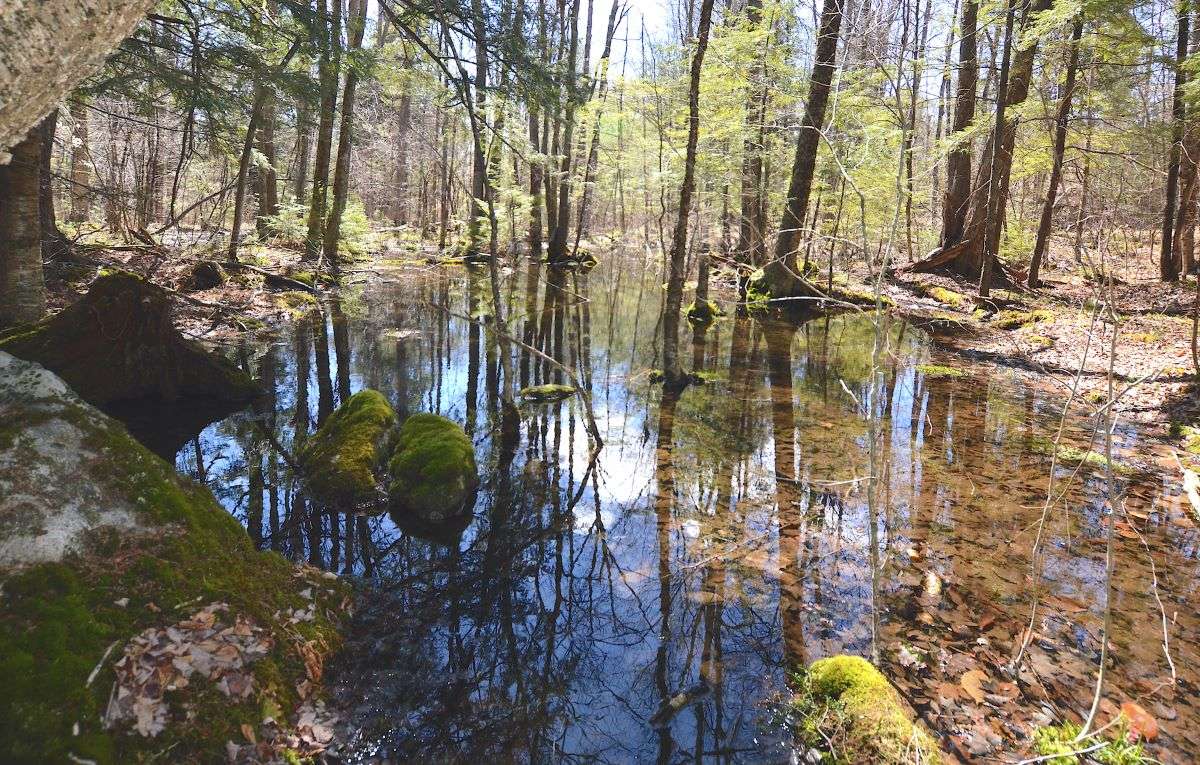Out In The Woods
- March 15th 2024
- Out in the Woods

Vernal pool at the McKeon Reserve
Photo: K. McKeon
The Big Night
By Kevin McKeon, Director, Mousam Way Land Trust
About 370 million years ago, the first animals crawled out of the oceans to live on land. Known as amphibians (two lives), they still require water for part of their life cycle, and later develop lungs and legs for their life on land. They are also cold-blooded and assume a body temperature equal to their surrounding environment – warming themselves by basking in the sun and cooling down by lounging in a pool of water. Amphibians have specialized skin that allows them to absorb oxygen from water, called cutaneous respiration, and many also have lungs for breathing out of water. Their skin dries easily, so a wet or damp environment, such as a vernal pool, is usually nearby.
Vernal pools are special bodies of water, having no inlet or outlet, and are unable to sustain some aquatic predators, such as fish and some invertebrates. They are also readily found throughout the landscape; anywhere a depression exists, a pool of water likely forms for a short period. These pools can also be a variety of sizes. Be it as large as a permanent wetland and several feet deep, or only a few square meters with inches of water, it seems nearly any pool size will suffice for a breeding amphibian. Click for more on Vernal Pools. https://mousamwaylandtrust.org/2018/08/03/vernal-pools/.
Certain early spring conditions trigger a massive migration, when amphibians travel from their woodsy homes to vernal pools to breed. When the snow melts and the ground thaws, and temperatures rise above 45 degrees Fahrenheit on a very wet night, either rainy or foggy, The Big Night event happens. This event sometimes happens during a single night, but often over several nights. Vernal Pools become swelled with the snowmelt and wet weather, and our amorous crawlers are answering the call to procreate!
Traveling back to their breeding waters often requires them to cross roads, and upwards of 30% of our frog, toad and salamander friends are killed by human road traffic as they cross to get to the pools, and again to return to their woodsy homes. Of the near 8,000 described amphibian species, almost half are in decline. According to a recent International Union for Conservation of Nature (IUCN) Red List report, over a quarter of amphibians are currently at risk of extinction, making them one of the most threatened groups of animals on the planet.
Hope does exist, however. A small yet fast-growing movement involves citizens throughout the northeastern U.S. who have been taking notice of the challenges migrating amphibians face as they attempt road crossing. The Maine Big Night project https://www.facebook.com/groups/bignightmaine focuses on recruiting volunteers to go out into the warm, rainy nights of spring to monitor key migration points on roads. Not only are volunteers assisting amphibians in crossing roads, they are also collecting valuable data that could help to both detect critical crossing points and increase habitat connectivity areas.
While driving along roads, many of us are accustomed to swerving around those amphibians that we can see and helping them cross when we stop. The Maine Department of Transportation (MDOT) has noticed the dangers motorists thus create, so single and multiple vehicle road accidents are being tabulated along with road damage. The evidence shows that as folks instinctively try to avoid needlessly killing these creatures, the costs of accident responses and road repairs are mounting. So MDOT is partnering with The Big Night project, Maine Department of Inland Fisheries and Wildlife, and other parties to design and build amphibian crossings into new road construction projects as a known cost-saving action.






